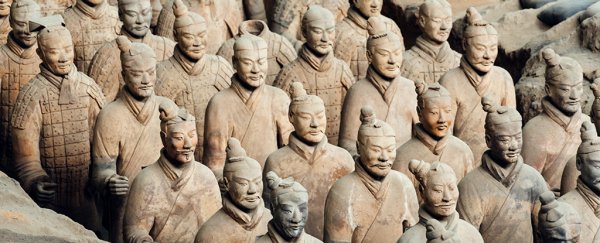The bronze weapons of the famous Terracotta Army in China have been remarkably well preserved over the last 2,000 or so years.
So well preserved, in fact, that up until now there have been hypotheses that ancient China had some kind of high-tech preservation technique that kept them in such good condition. Now scientists think they've solved the mystery.
The soil surrounding the interred weapons could be mostly responsible for their good condition, suggest the researchers, not some kind of fancy chromate coating – a hypothesis that has before now been popular with experts.
Instead, the new research says the traces of chromium found on the spears, swords, and other weapons were actually left behind from protective layers of lacquer applied to the warrior figures, and not applied to the weapons directly.
So what's so good about the soil? The moderately alkaline pH, small particle size and low organic content in the soil would have all helped guard against decay.
High tin levels in the bronze metal used for the Terracotta Army weapons would also have aided preservation, the researchers say.
"We found a substantial chromium content in the lacquer, but only a trace of chromium in the nearby pigments and soil – possibly contamination," says lead researcher Marcos Martinón-Torres, from the University of Cambridge in the UK.
"The highest traces of chromium found on bronzes are always on weapon parts directly associated to now-decayed organic elements, such as lance shafts and sword grips made of wood and bamboo, which would also have had a lacquer coating."
"Clearly, the lacquer is the unintended source of the chromium on the bronzes – and not an ancient anti-rust treatment."
What's more, some of the most well-preserved swords and lance blades have very little chromium attached to them, adding to the evidence that something else is at work.
However, the researchers aren't ruling out some kind of clever preservation technique entirely – it just appears that a chromium treatment is unlikely to be it.
Similar ideas have been proposed before – with other researchers showing that compact tin in the weapons also helped preserve them – but those papers had a more limited sample size than this latest study.
In total, the researchers behind the new study looked at 464 different bronze weapons for the presence and amount of chromium. They also took on-site measurements of the soil, proposing for the first time that the soil helped keep the blades so sharp and shiny.
The make-up of the soil analysed by the researchers is very different to somewhere like Britain, where ancient bronze weaponry is much less well preserved. The team ran tests in a lab chamber to verify the excellent preservation qualities of the Xi'an soil.
First discovered in 1974, the Terracotta Army – thousands of ceramic figures buried underground to guard over the first emperor of China Qin Shi Huang – remains one of the greatest archaeological finds in history.
And as this new study shows, the site continues to fascinate archaeologists and reveal new secrets. It can even point back to the movements of populations through time.
"It is striking how many important, detailed insights can be recovered via the evidence of both the natural materials and complex artificial recipes found across the mausoleum complex – bronze, clay, wood, lacquer and pigments to name but a few," says one of the team, Andrew Bevan from University College London in the UK.
"These materials provide complementary storylines in a bigger tale of craft production strategies at the dawn of China's first empire."
The research has been published in Scientific Reports.
